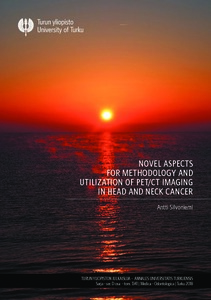Novel aspects for methodology and utilization of PET/CT imaging in head and neck cancer
Silvoniemi, Antti (2018-05-04)
Novel aspects for methodology and utilization of PET/CT imaging in head and neck cancer
Silvoniemi, Antti
(04.05.2018)
Turun yliopisto
Julkaisun pysyvä osoite on:
https://urn.fi/URN:ISBN:978-951-29-7186-2
https://urn.fi/URN:ISBN:978-951-29-7186-2
Kuvaus
ei tietoa saavutettavuudesta
Tiivistelmä
Avainsanat: PET, PET/TT, pään ja kaulan alueen syöpä, [18F]EF5, [18F]FDG, hypoksia, molekulaarinen kuvantaminen, sädehoidon suunnittelu
Positron emission tomography (PET), combined with computed tomography (CT),plays a key role in the management of head and neck cancer (HNC). In this thesis, novel aspects for PET/CT imaging of HNC regarding low oxygen levels, or hypoxia, and detection of glucose metabolism were evaluated. Hypoxia is a frequently observed hallmark of cancer contributing to radiotherapy resistance and poor prognosis. Enhanced glucose metabolism is characteristic of a malignant tumor, which is exploited in an everyday clinical application of [18F]FDG PET imaging.
This study aimed to further investigate the feasibility of a novel hypoxia PET tracer [18F]EF5 and the potential of dynamic [18F]FDG PET/CT imaging in HNC. The first study indicated a favorable human biodistribution and radiation dosimetric profile of the hypoxia tracer [18F]EF5. The second preclinical study showed that the growth rate of human HNC xenografts in nude mice during the exponential growth period correlated with [18F]EF5 uptake in PET/CT images. In the third study, paired [18F]EF5 PET/CT scans performed for untreated HNC patients with a median time interval of seven days presented predominantly highly repeatable results. In the fourth study, advanced mathematical methodology for tracer uptake analysis was evaluated using dynamic [18F]FDG PET/CT in patients who were referred to chemoradiotherapy for oropharyngeal cancer. However, the method showed only a modest performance in the distinction of malignant, inflammatory and healthy tissues. In conclusion, further evaluation of [18F]EF5 PET/CT imaging and dynamic [18F]FDG PET/CT imaging seems important in the development of more effective strategies for the management of HNC.
Positron emission tomography (PET), combined with computed tomography (CT),plays a key role in the management of head and neck cancer (HNC). In this thesis, novel aspects for PET/CT imaging of HNC regarding low oxygen levels, or hypoxia, and detection of glucose metabolism were evaluated. Hypoxia is a frequently observed hallmark of cancer contributing to radiotherapy resistance and poor prognosis. Enhanced glucose metabolism is characteristic of a malignant tumor, which is exploited in an everyday clinical application of [18F]FDG PET imaging.
This study aimed to further investigate the feasibility of a novel hypoxia PET tracer [18F]EF5 and the potential of dynamic [18F]FDG PET/CT imaging in HNC. The first study indicated a favorable human biodistribution and radiation dosimetric profile of the hypoxia tracer [18F]EF5. The second preclinical study showed that the growth rate of human HNC xenografts in nude mice during the exponential growth period correlated with [18F]EF5 uptake in PET/CT images. In the third study, paired [18F]EF5 PET/CT scans performed for untreated HNC patients with a median time interval of seven days presented predominantly highly repeatable results. In the fourth study, advanced mathematical methodology for tracer uptake analysis was evaluated using dynamic [18F]FDG PET/CT in patients who were referred to chemoradiotherapy for oropharyngeal cancer. However, the method showed only a modest performance in the distinction of malignant, inflammatory and healthy tissues. In conclusion, further evaluation of [18F]EF5 PET/CT imaging and dynamic [18F]FDG PET/CT imaging seems important in the development of more effective strategies for the management of HNC.
Kokoelmat
- Väitöskirjat [2960]
